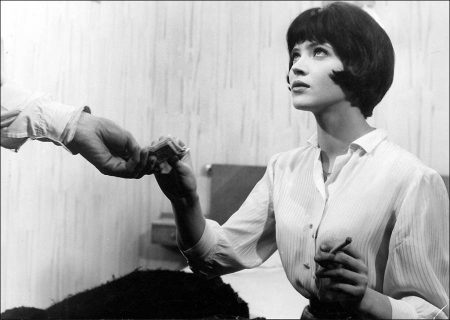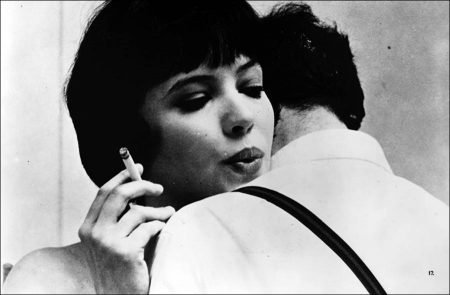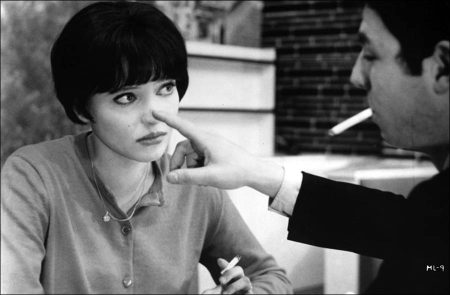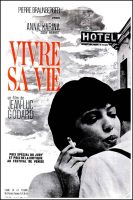Taglines: The many faces of a woman trying to find herself in a world of men.
My Life to Live movie storyline. Nana (Anna Karina), a beautiful Parisian in her early twenties, leaves her husband and infant son hoping to become an actress. Without money, beyond what she earns as a shopgirl, and unable to enter acting, she elects to earn better money as a prostitute. Soon she has a pimp, Raoul, who after an unspecified period agrees to sell Nana to another pimp. During the exchange, the pimps argue and Nana is killed in a gun battle. Nana’s short life on film is told in 12 brief episodes, each preceded by a written intertitle.
My Life to Live (French: Vivre sa Vie: film en Douze Tableaux; To Live Her Life: A Film in Twelve Scenes) is a 1962 French New Wave drama film directed by Jean-Luc Godard. It was released as My Life to Live in North America and as It’s My Life in United Kingdom. The DVD releases use the original French title.
Influences of the Film
One of the film’s original sources is a study of contemporary prostitution, Où en est la prostitution by Marcel Sacotte, an examining magistrate.
Vivre sa vie was released shortly after Cahiers du cinéma (the film magazine for which Godard occasionally wrote) published an issue devoted to Bertolt Brecht and his theory of ‘epic theatre’. Godard may have been influenced by it, as Vivre sa vie uses several alienation effects: twelve intertitles appear before the film’s ‘chapters’ explaining what will happen next; jump cuts disrupt the editing flow; characters are shot from behind when they are talking; they are strongly backlit; they talk directly to the camera; the statistical results derived from official questionnaires are given in a voice-over; and so on.
The film also draws from the writings of Montaigne, Baudelaire, Zola and Edgar Allan Poe, to the cinema of Robert Bresson, Jean Renoir and Carl Dreyer. And Jean Douchet, the French critic, has written that Godard’s film “would have been impossible without Street of Shame, Kenji Mizoguchi’s last and most sublime film.”

Nana gets into an earnest discussion with a philosopher (played by Brice Parain, Godard’s former philosophy tutor), about the limits of speech and written language. In the next scene, as if to illustrate this point, the sound track ceases and the images are overlaid by Godard’s personal narration. This formal playfulness is typical for the way in which the director was working with sound and vision during this period.
The film depicts the consumerist culture of Godard’s Paris; a shiny new world of cinemas, coffee bars, neon-lit pool halls, pop records, photographs, wall posters, pin-ups, pinball machines, juke boxes, foreign cars, the latest hairstyles, typewriters, advertising, gangsters and Americana. It also features allusions to popular culture; for example, the scene where a melancholy young man walks into a café, puts on a juke box disc, and then sits down to listen.
The unnamed actor is in fact the well known singer-songwriter Jean Ferrat, who is performing his own hit tune “Ma Môme” on the track that he has just selected. Nana’s bobbed haircut replicates that made famous by Louise Brooks in the 1928 film Pandora’s Box, where the doomed heroine also falls into a life of prostitution and violent death. In one sequence we are shown a queue outside a Paris cinema waiting to see Jules et Jim, the new wave film directed by François Truffaut, at the time both a close friend and sometime rival of Godard.
My Life to Live (1962)
Directed by: Jean-Luc Godard
Starring: Anna Karina, Sady Rebbot, André S. Labarthe, Guylaine Schlumberger, Gérard Hoffman, Monique Messine, Paul Pavel, Dimitri Dineff, Peter Kassovitz, Odile Geoffroy, Marcel Charton
Screenplay by: Jean-Luc Godard
Cinematography by: Raoul Coutard
Film Editing by: Jean-Luc Godard, Agnès Guillemot
Costume Design by: Christiane Fageol
Music by: Michel Legrand
MPAA Rating: None.
Distributed by: Panthéon Distribution
Release Date: September 20, 1962 (France)
Views: 333


